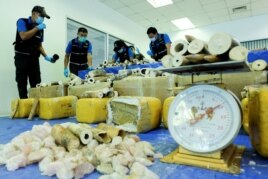24 September, 2018
Researchers are using DNA evidence to fight the illegal trade in ivory. They have shown how genetic testing is able to link seizures of valuable elephant tusks to ivory traffickers.
In a report, the researchers says targeting ivory smugglers could have a major effect on elephant poaching. Wildlife experts note that illegal hunting threatens the very existence of the animals.
The findings mean some ivory smuggling suspects already facing charges from earlier arrests could face additional charges or larger fines if found guilty.
Ivory trafficking is a huge business with ties to other illegal activities, including drug trafficking. Poachers kill an estimated 40,000 elephants each year.
Missing tusks
Samuel Wasser is a biologist with the University of Washington. He and other researchers have studied tusks seized in police raids to identify where poached elephants came from. They had earlier identified places in Tanzania and Mozambique from which almost all the ivory seized between 2006 and 2014 came.
Wasser and the team noticed that when ivory shipments were seized, they often only contained one of an elephant's two tusks. They examined genetic records from major raids on smugglers between 2006 and 2015.
The records had information about DNA, short for deoxyribonucleic acid. The chemical is found in nearly all creatures and carries genetic information.
The researchers reported finding 26 examples where a tusk from one seizure was genetically similar to one from a separate shipment.
In each case, the two shipments passed through the same port within a few months of each other. Wasser said that suggests the same major trafficking organization was responsible for shipping both.

FILE - Thai forensic experts collect DNA samples from a confiscated elephant tusk, coming from Malawi, at Suvarnabhumi International Airport in Bangkok, Thailand, March 7, 2017.
The study was published in the journal Science Advances. It follows the ivory back to three major trafficking groups. They are based in Lomé, Togo; Mombasa, Kenya; and Entebbe, Uganda.
When traffickers are caught, they usually only face charges for one shipment. But the methods Wasser's group developed can link individual smugglers to more than one shipment, and to each other.
For example, an important suspect in the Uganda group currently is awaiting trial for one seizure. The new study links him to two others. One of those includes tusks from a 2012 incident where poachers in a Ugandan helicopter shot 22 elephants across the border in the Democratic Republic of the Congo.
"You can imagine, if this evidence is used, how much stronger a case we can build against him," Wasser said.
International links found
The new study also finds links between the criminal organizations in Togo and Kenya. East African and West African tusks were found in a shipment seized in Malaysia. Ivory from this shipment is connected to tusks from separate seizures linked to Lomé and Mombasa.
East African drug-smuggling suspects facing charges in the United States have also been linked to the Kenyan ivory trafficking group.
Frank Pope heads the nonprofit group Save the Elephants. He believes that the stories coming from the new study are very important. "Wasser's work is helping us to close in on networks by telling the story of the connections between the different shipments," Pope said.
Wasser's methods have already helped investigators interfere with trafficking operations, notes John Brown, a special agent with the Department of Homeland Security Investigations.
But Brown notes that few countries are obeying orders to send ivory collected in raids for genetic testing. This makes it harder for law enforcement to get to the beginning of the problem, he added.
"A seizure of three tons of ivory looks very good on the front page of the local newspaper," Brown said. "But if we don't attack the transnational criminal organizations behind it, then the problem will continue."
I'm Phil Dierking.
Steve Baragona reported this story for VOANews. Phil Dierking adapted his report for Learning English. George Grow was the editor.
Write to us in the Comments Section or on 51VOA.COM.
_____________________________________________________________
Words in This Story
poach - v. to hunt or fish illegally
smuggle - v. to move (someone or something) from one country into another illegally and secretly
trafficker - n. a person who buys and sells something that is illegal
tusk - n. a very long, large tooth that sticks out of the mouth of an animal